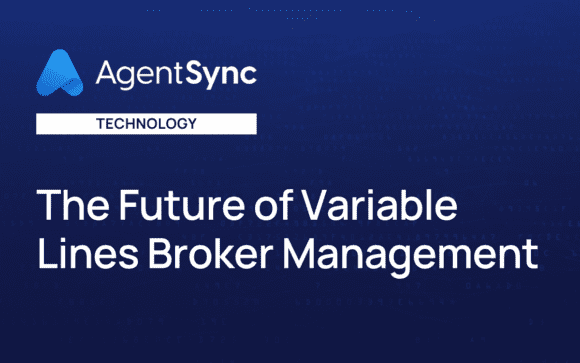The Future of Variable Lines Broker Management

This post is part of a series sponsored by AgentSync.
Key takeaways:
What automation looks like for variable lines compliance
How automated broker compliance can help or harm carrier reputations
Why broker preferences are the future of variable annuity and variable insurance distribution
How automated variable lines broker compliance will affect the bottom line
Why life insurance carriers are automating broker compliance
It’s not a secret that, for insurance carrier compliance and operations teams the world over, managing the variable lines broker lifecycle is complex.
It’s also a point of friction for variable lines brokers themselves. Repetitive manual entry for multiple systems, filling out multiple points of information only to have an onboarding team send over yet another link to fill out The. Same. Information. Again…
Many life insurance carriers know all too well that their broker management practices leave them exposed to unnecessary risks and are unwieldy for the brokers they appoint. Yet, with legacy systems that house sometimes centuries of data, making the move to a modern compliance management system is a daunting challenge.
But, with Ajit Jain, Vice Chairman of Insurance Operations for Berkshire Hathaway proclaiming that legacy insurers must spend the next few years condensing their tech systems from hundreds of softwares to tens of softwares, perhaps other carriers will take note: Integrated, automated tech can take your internal operations from a huge cost center to a cost savings; and the longer you delay, the higher your pain.
Let’s consider a world where a compliance management system automates much of the process for these brokers, and what it could look like for insurance carriers and brokers alike.
Imagine the future of variable lines broker management
By its very nature, variable lines compliance requires carrier and MGU teams to monitor insurance licensing data and securities information. For the insurance side of the business, this means taking in E&O data, completing a background check, verifying state licensing, and making appointments. For the securities side, you have to draw information from the Financial Industry Regulatory Authority (FINRA) to verify that your broker has passed a Series exam, in addition to validating things like E&O data, completing a background check, etc. (You might be sensing a theme.)
Imagine, then, a future state, one in which multiple teams can access the relevant compliance data from multiple sources of truth for a single view of total compliance for your broker force. Instead of data silos, imagine using software that surfaces insurance and securities data in a unified view. A solution that seamlessly integrates into other software for your compliance team to enforce the appropriate variable lines disclosures for a broker, or for your commissions payment system to stop inappropriate commissions payments before they happen.
5 reasons automating variable lines compliance is crucial to insurance carrier reputations
This future state may seem out of reach if you’re living in difficult-to-navigate legacy systems. But rest assured, we’re no longer in the Wild West of early tech adoption. At this point, if you’re not considering cloud-based applications and automations to bring both speed and ease of use to your daily processes, you risk being left behind by the carriers, MGAs, and MGUs of your cohort.
1. Attract better distribution partners
When you automate more pieces of your broker compliance process, this has follow-on effects for your distribution partners. Downstream agencies and firms that have to chase their brokers to comply with your requests for information find themselves caught in the same paper turmoil that your internal teams recon with. By automating onboarding and unifying your data views from sources of truth, your partners (and you) spend less time on data collection and more time building relationships.
2. Make it easier for your distribution partners to recruit brokers
Your distribution channel is only as good as your partners. When you make it easier for brokers to onboard, contract, and stay in compliance with your carrier or MGU requirements, you make it easier for your distribution partners to attract and retain talented brokers. Once again, this serves as a boon to your overall reputation, stoking the kind of word-of-mouth organic referral that you just can’t buy.
3. Simplify compliance audits for life insurance carriers
Part of maintaining a sterling reputation in the insurance industry is in maintaining good relationships with state and federal regulators. By moving out of outdated systems, you can work with automated compliance software that time stamps your activity to make complying with state and industry audits a breeze, with no or low internal reporting costs.
4. End data silos for variable product disclosure requirements and other variable-product-specific regulations
Who do you want to work with – a business that makes you re-enter your information for every team and frequently sends the wrong set of information to you, or one that’s buttoned-up processes sends you correct, streamlined information each time?
The reality is, brokers selling variable life insurance and variable annuity products will have higher standards for disclosures and maintaining records. But, frequently, carriers and MGUs treat variable brokers the same as their life-only producers. By automating dually licensed communications and ending data silos for your internal teams, you can give everyone a source of truth with unified licensing information to ensure your brokers get the right paperwork to fill out, the relevant disclosure information, and the pertinent record-keeping standards the first time and every time.
5. Maintain parity with similarly positioned variable lines life insurance carriers
By 2017, nearly a third of life and health carriers’ internal operations costs had become technology-based, according to a McKinsey study. Carriers that took a digital-first approach to internal operations in that period shrunk their expense ratios 40 percent more than their traditional legacy peers. Five years later, operational efficiency isn’t cutting edge, it’s the expected norm.
Carriers and variable lines insurers that delay using automation for operational efficiency are losing ground to businesses that have taken a more proactive approach to their internal tech stacks. While securities compliance adds a layer of complexity, it doesn’t have to hold you back.
7 ways to turn automated variable lines broker compliance into a cost savings
1. Limit risk
Automatic compliance and easy compliance data reporting for audit records limit your exposure to fines from state departments of insurance and FINRA. Additionally, having an easy-to-access audit trail complete with time stamping and historical data make it easy to comply in the event that you end up on the wrong side of a compliance investigation. Instead of paying teams of people to gather stacks of data, integrated reporting capabilities make complying with a state investigation a low-cost, low-hassle event.
2. Limit appointment costs
With Just-In-Time appointment capabilities, you can use timely onboarding processes to appoint only those brokers that are actively writing business for you. By validating personal data and automatically conducting background checks, you can meet state limits for appointment deadlines with ease, saving thousands of dollars lost to slow, proactive, unnecessary appointments.
3. Limit cost of new employee acquisition
Plenty of people will take jobs doing manual data entry. But not many will stay in that job once they have an opportunity for higher-level work. By automating many of the tasks that require repetitive manual data entry, you can avoid the churn of entry-level employees while freeing up your senior staff to spend more time on higher level work like relationship building, data analysis, and strategic planning.
4. Limit the cost of recruiting partners
If you saw the benefits to your reputation of automating more of your broker management lifecycle, then you’ll understand the potential you have for organic reputation building. Knowing your brokers and downstream distribution partners are satisfied is a sure way to keep your funnel filled. Put another way: If other businesses genuinely enjoy working with you, you don’t have to pay as much to try to convince new business partners that they will, too.
5. Limit compliance headcount
Variable lines have had plenty of new regulations roll out in the last few years, and we suspect it’s not over. If carriers and MGUs have ever-expanding oversight duties, that could mean ever-expanding employee headcount. That’s frankly not sustainable if you also have a bottom line you have to meet. So, either you can work harder, hire more people in operations and compliance, and spin on a hamster wheel of expansion to keep up with the regulatory Whack-a-Mole, or you can work smarter to automate as many of those duties as is practicable.
6. Limit cost of legacy systems
To give legacy systems their due, they’ve kept the industry going for a long time, and they often have decades, sometimes centuries, of sensitive data baked in. Coming off of a legacy system is no small task. But legacy systems also come with significant costs. For one thing, state and FINRA regulations change constantly. For another, technology standards are constantly shifting. DOS was once cutting edge. Now, low-code and cloud-based systems can outmaneuver tech that was hot five years ago.
Not only does that translate to a cost for your internal operations, but legacy systems can also represent a significant risk in terms of data protection if they aren’t following best practices.
7. Get more out of what you have
Automated, integrated broker compliance means making life easier for your employees and your external broker force, but it also means getting more out of the tech you’ve already invested in. An automated function could check every commission payment before it goes out to ensure it’s only paid to properly licensed and appointed brokers. A change to an address in your client relationship management system could trigger an address update across all systems. Your compliance system could send out important reminders based on a calendar trigger, with no one having to copy and paste information over and over.
Time is money, and by automating your broker compliance processes, you can waste less of it.
AgentSync Manage offers enhanced variable insurance support that unifies FINRA and insurance data into a single profile, providing a consolidated view of broker eligibility for informed decision-making, accelerated onboarding, and compliance. To make these fantastic attributes work for you, schedule a demo.
Topics
Trends
Agencies






